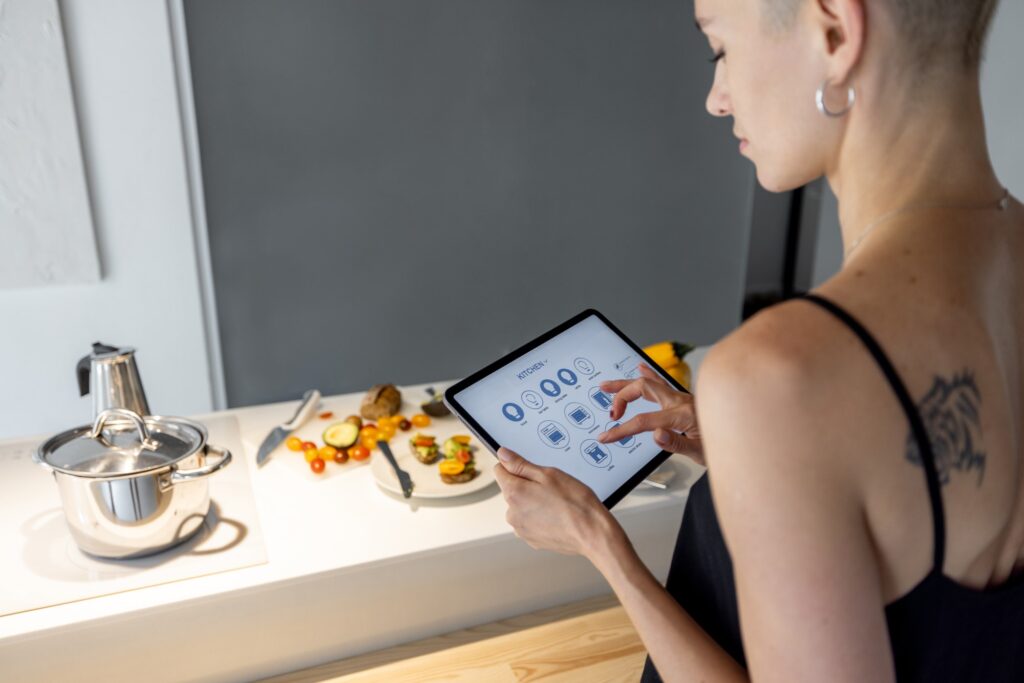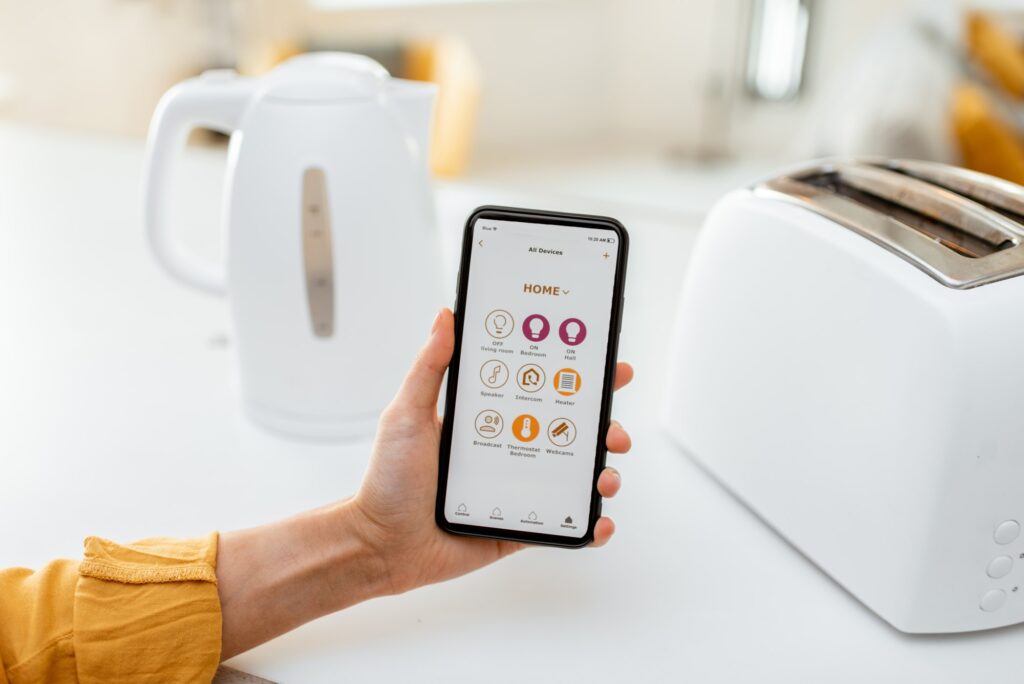The modern world is witnessing an unparalleled transformation in the heart of our homes: the kitchen. With the convergence of technology and innovation, the emergence of smart kitchens has transformed how we approach cooking, dining, and home management. In this comprehensive guide, we’ll embark on a journey through the realm of smart kitchens, exploring the myriad ways in which technology is enhancing our cooking experiences and simplifying our daily routines. Join us as we delve into the wonders that await in this exciting fusion of culinary mastery and modern tech.
Introduction to Smart Kitchen Technology

Defining Smart Kitchen Appliances
Smart kitchen appliances are a testament to the seamless fusion of traditional functionality with cutting-edge technology. These intelligent devices redefine the culinary landscape by offering features that go beyond the basics. Ranging from refrigerators to ovens and everything in between, they boast connectivity, automation, and smart controls that elevate the cooking experience. Leveraging advanced technology such as IoT (Internet of Things) connectivity and AI (Artificial Intelligence), these appliances are designed to deliver unparalleled convenience, efficiency, and functionality within the kitchen.
Evolution of Smart Technology in Kitchens
The evolution of smart technology in kitchens has been nothing short of revolutionary, transforming the heart of our homes into hubs of innovation and convenience. The inception of smart kitchens began with the introduction of basic automated appliances. Over time, these appliances have become part of a sophisticated ecosystem that integrates the Internet of Things (IoT), AI, and seamless connectivity. This evolution has redefined the traditional kitchen into a space that is not only functional but also intelligent and responsive.
Also Read: The Art of Lighting: Navigating Smart Light Dimming and Ambiance Control.
Benefits of Smart Kitchen Appliances
1. Convenience and Time-saving Features
One of the most significant advantages of smart kitchen appliances is the unprecedented level of convenience they offer. Imagine being able to control and monitor your kitchen devices remotely. Smart appliances allow users to preset cooking times, temperatures, and settings, enabling multitasking and freeing up time for other activities.
2. Energy Efficiency and Cost Savings
Smart appliances are designed with energy efficiency in mind. They often come equipped with features such as programmable timers, optimal temperature control, and power-saving modes. This not only reduces energy consumption but also translates into cost savings on utility bills. As consumers become more environmentally conscious, the energy-efficient nature of smart kitchen devices aligns with sustainable living practices.
3. Enhanced Cooking Experience and Customization
Smart kitchen devices provide users with an enhanced cooking experience through customization options. From adjusting cooking settings to personalizing recipes, these appliances cater to individual preferences. The ability to experiment with cooking techniques and flavors adds a new dimension to the culinary journey, making it more enjoyable and rewarding.
Key Features of Smart Kitchen Appliances
1. Connectivity and IoT Integration
Connectivity is a hallmark of smart kitchen appliances. These devices can be linked to smartphones, tablets, or other smart home systems, allowing users to control and monitor them remotely. The seamless integration of IoT enables different devices to communicate with each other, creating a synchronized and efficient kitchen environment.
2. Automation and Voice Control
Automation is a key feature that sets smart kitchen appliances apart. Tasks such as preheating ovens, brewing coffee, or defrosting food can be automated, saving users time and effort. Voice control adds an extra layer of convenience, allowing users to operate appliances through voice commands, making the kitchen a hands-free zone.
3. Advanced Cooking Techniques and Sensors
Smart kitchen appliances often come with advanced cooking features and sensors. These can include precision temperature control, built-in recipe suggestions, and even sensors that adjust cooking times based on the readiness of the food. These technologies contribute to consistently high-quality results in the kitchen.
Popular Smart Kitchen Devices
1. Smart Refrigerators:
– Equipped with touchscreens, cameras, and connectivity for managing groceries, creating shopping lists, and accessing recipes. They can track inventory, suggest recipes based on available ingredients, and even provide real-time updates on expiration dates. Some models even allow users to view the contents of their fridges remotely through built-in cameras.
2. Smart Ovens:
– Offer advanced cooking capabilities. From preheating on the way home to adjusting temperatures remotely, these appliances give users greater control over the cooking process. Some models also come with built-in cameras for monitoring food as it cooks.
3. Smart Coffee Makers:
– Brew your favorite coffee with a simple voice command or schedule it through a mobile app.
4. Smart Cooktops:
– Induction cooktops with smart controls for precise cooking and enhanced safety features.
5. Smart Blenders and Food Processors:
– Controlled remotely for seamless blending or chopping, often with customizable settings.
6. Smart Dishwashers:
– Connected for remote monitoring, and some models can even reorder detergent when supplies are low.
7. Smart Sous Vide Precision Cookers:
– Precision cooking devices controlled via mobile apps, ensuring consistent and perfect results.
8. Smart Slow Cookers:
– Programmable and controllable remotely for convenient, slow-cooked meals.
9. Smart Scales:
– Connect to recipe apps, providing precise measurements for accurate cooking.
10. Smart Kitchen Hubs:
– Centralized devices integrating multiple functions, such as recipe guidance, video calls, and smart home control.
11. Smart Air Fryers:
– Combine traditional cooking methods with air frying technology, controllable via apps.
12. Smart Water Dispensers:
– Dispense water at customizable temperatures and quantities, often with filtration features.
13. Smart Thermometers:
– Monitor cooking temperatures in real-time through mobile apps for perfect results.
14. Smart Kettles:
– Boil water remotely or schedule boiling times for tea or coffee preparation.
15. Smart Kitchen Sinks:
– Equipped with touchless controls, water temperature presets, and sometimes integrated smart home features.
These devices represent a glimpse into the diverse and expanding world of smart kitchen technology, offering convenience, automation, and efficiency to modern households.
Tips for Setting Up a Smart Kitchen
1. Assess Your Needs:
Before diving into purchasing smart appliances, assess your cooking habits and preferences. Identify which tasks you’d like to streamline or automate in your kitchen.
2. Plan Connectivity:
Consider your home’s Wi-Fi capabilities and ensure a stable internet connection throughout the kitchen area. Some smart appliances rely on connectivity for optimal functionality.
3. Start Gradually:
Begin by introducing a few essential smart devices, such as a smart oven or a connected refrigerator. Starting small allows for a smoother transition and better understanding of how these devices fit into your routine.
4. Check Compatibility:
Ensure that the smart appliances you choose are compatible with each other or can integrate into a unified system. Some brands have ecosystems that work seamlessly together, while others might have limitations in connectivity.
5. Research Features:
Explore the features offered by different smart appliances. Look for functionalities that align with your needs, such as remote monitoring, voice control, energy-saving modes, or recipe suggestions.
6. Consider User Interface:
Opt for appliances with user-friendly interfaces. A straightforward and intuitive control panel or app interface can make your experience much more enjoyable and accessible.
7. Installation and Setup:
Follow manufacturer instructions for installation carefully. Some devices might require professional installation, while others can be set up easily using provided guidelines or apps.
8. Learn How to Use:
Take the time to familiarize yourself with the features and functionalities of each smart appliance. Understanding how to maximize their capabilities ensures you make the most of your investment.
9. Explore Integration:
Experiment with integrating different devices and exploring how they work together. This experimentation can help optimize your smart kitchen setup for efficiency.
10. Stay Updated:
Keep your smart appliances updated with the latest software versions. Manufacturers often release updates that improve performance, security, and add new features.
11. Security Measures:
Pay attention to the security measures provided by the manufacturer. Set up strong passwords, enable encryption if available, and take advantage of privacy settings to protect your data.
12. Consider Long-Term Benefits:
While initial costs might be higher for smart appliances, consider the long-term benefits in terms of energy savings, convenience, and potential increases in home value.
13. User Support and Warranty:
Check for available customer support and warranty options. Having reliable support and warranty coverage can be beneficial in case of any issues with the appliances.
14. Feedback and Adaptation:
Be open to adapting your kitchen setup based on your experiences and feedback. Understanding how these appliances impact your daily routine helps in optimizing their usage.
15. Enjoy the Experience:
Embrace the convenience and possibilities that smart kitchen appliances offer. Experiment with new recipes, utilize automation and enjoy a more efficient and personalized cooking experience.
Setting up a smart kitchen can significantly enhance your cooking experience. By considering these tips, you can create a well-integrated and efficient kitchen that suits your lifestyle and culinary preferences.
In conclusion, the evolution of smart kitchen technology signifies a remarkable shift from basic automation to a sophisticated ecosystem of interconnected devices. In the symphony of sizzles, dings, and delightful aromas that compose the modern kitchen, smart technology has emerged as the conductor, orchestrating a seamless and innovative culinary experience. So, let the aroma of progress linger in your kitchen, where the clinks of utensils harmonize with the hum of technology. The smart kitchen is not just a trend – it’s a transformative journey into the heart of our homes, where every meal becomes an exquisite blend of tradition and technology. Here’s to the future of cooking – where each dish is a masterpiece, and the kitchen is a stage for culinary excellence and innovation.
